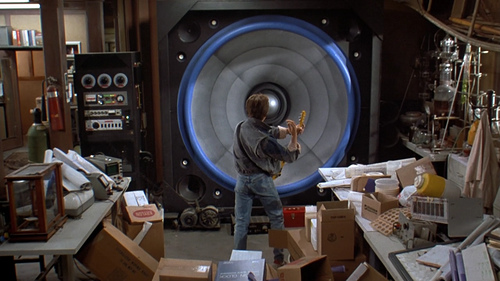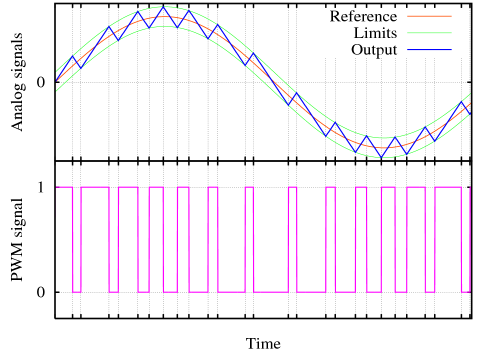
The maximum theoretical efficiency for a linear amplifier is about 78.5%. This assumes zero idle losses and static supply rails (i.e. not a class-G or class-H amplifier). The maximum theoretical efficiency of a switching amplifier is 100%. This assumes zero idle losses and “perfect” switching devices. Of course you can never really achieve 100% efficiency – the second law of thermodynamics forbids this – but you can achieve 90%, 99%, 99.9% and 99.99% as the technology improves to allow for it.
The determination of efficiency is a fairly straightforward measurement for a given product. Unfortunately, marketing sometimes gets a hold of it and the following scenario occurs:
Worldly marketing type: “Hey Bob, sweet amp.”
Innocent engineering type: “Gee Fred, ya think so? Thanks!”
Worldly marketing type: “Yah, but we could really improve our position against XYZ if the efficiency were higher than 75%…”
Innocent engineering type: “But I’m giving the end-to-end efficiency and XYZ is claiming an efficiency of 99.5% by only including the losses in the power cord!”
Worldly marketing type: “Uh-huh.”
Innocent engineering type: [Exasperated] “Okay, fine. I’ll work on it after I take my Honda in for an oil change at lunch. How’s the Bimmer working out for ya?”
Worldly marketing type: “Fine, just fine.”
The bit about the car types was inspired by Guy Kawasaki.
Posted in Switching Amplifiers | Comments Off on Class-D Efficiency

The following are wonderful examples of audio companies using their websites both for commercial and for educational purposes. My hope is to live up to the standard they set by helping to expand the body of knowledge in audio and by providing the sort of products my customers love.
Elliott Sound Products
Linkwitz Lab
Pass Labs
Rane
The following websites do not have a commercial angle to them, but they are indispensable resources. They have been tremendously helpful to me in my products, projects, and overall audio knowledge.
Nutshell High Fidelity
Art Ludwig’s Sound Page
Posted in General Audio | Comments Off on Creme de la Creme

It is difficult to relate the intricacies of one’s approach to audio design, but these three articles do a reasonable job of summing up my design philosophy:
One of the most important requirements for designing a really good switching amplifier is Solid Execution.
A general critieria for designing good sounding audio equipment is given by the concept of Disappearing Derivatives.
Objectivists versus Subjectivists and the Engineering Perspective.
Posted in General Audio | Comments Off on My Design Philosophy

For a good introduction to neural networks, please refer to the online course content of CS-449 from Genevieve Orr. There are also many, many good texts on the application of neural networks, one of which is Neural Smithing by Reed and Marks.
Neural networks hold great potential for many fields – especially digital signal processing for audio. To the best of my knowledge, there has been minimal application of neural network algorithms in consumer audio, professional audio, or audiophile products. There has been some active research however, such as these papers from Malcolm Hawksford.
A simple example of the application of neural networks is in the correction of loudspeaker anomalies. Standard linear digital filters (e.g. FIR and IIR) can correct for linear errors (e.g. frequency response), and they can even do so adaptively (e.g. the LMS filter), however they cannot correct nonlinearities. Neural networks are able to adaptively correct both linear and nonlinear errors via algorithms such as “Backpropagation” for Feed-Forward Neural Networks (FFNNs) and “Real-Time Recurrent Learning” (RTRL) for Recurrent Neural Networks (RNNs).
Posted in Signal Processing | Comments Off on Neural Networks for Audio

Given my great interest is amplifier design; it makes sense that I should also hold a great interest in loudspeaker design. I usually liken this to the profession of a shipwright: it makes a lot of sense to know a little bit about the ocean…
Earlier this year I designed and built my first dipole system, the VK-1 Dipole Loudspeaker. I had two particularly important goals for this design. First, the minimization of stored energy: the backwave from a driver needs to go somewhere and, although fiberglass is good at acoustic absorption, it still takes several reflections about the inside of an enclosure to drop to an insignificant level. Second, the proper “voicing” of each driver: an aluminum ribbon tweeter for airy highs, a paper former/hemp cone driver for natural midrange, and a large paper cone driver for solid bass.
After six months of listening the impossible has happened: I have not made any further “tweaks” to the system and the “honeymoon” is not over! It is a joy every time I sit down and listen to whatever I am in the mood for. It is certainly not the perfect system, and doubtless it would appeal more to some than to others, but for my personal tastes it comes fairly close.
Posted in Loudspeakers | 2 Comments »

Much has been made over the phenomenon of “supply pumping” in single-ended class-D amplifiers (i.e. not a full-bridge output). Maybe it is an issue, maybe it isn’t, but it is very difficult to answer that question unless we have some numbers to work with! This is not the sort of thing you can simply listen to on your reference system and say, “Yes, now I’m sure of it: roughly 15V peak at 20Hz.” Well, maybe you can, but I certainly can’t.
This article derives the magnitude of the supply pumping in terms of known parameters of the amplifier: rail voltage, bus capacitance, load impedance and frequency. It shows that the only variable the designer really has control over for the reduction of supply pumping is bus capacitance, at least without resorting to more advanced methods, but adding more capacitance is the simplest and gives the best results by far.
Posted in Switching Amplifiers | Comments Off on Class-D Supply Pumping

For an excellent introduction to the theory behind class-D amplifiers, please refer to “The Class-D Amplifier” by Marshall Leach. Dr. Leach is the designer of The Leach Amp, a highly regarded low-TIM amplifier.
Standard PWM modulation involves the use of the input signal, a reference triangle wave, and a comparator. If the PWM output itself is used to generate the triangle wave via an integrator, and a little hysteresis is added to provide an effective delay to help set the switching frequency, then a self-oscillating hysteresis modulator results.
Rather than using the delay resulting from hysteresis to help set the switching frequency, phase shift may be used to provide the delay around the loop. A particularly elegant way of doing this is to use the phase shift from the output filter itself – the result is a self-oscillating phase shift modulator. Not only is this simpler, as it makes use of components that are already required, but it has the benefit of reducing errors resulting from the output filter itself (e.g. frequency response anomalies).
There are many more approaches to class-D modulation, all with their own set of advantages, disadvantages, and oddities, but this is a good sampling for starters.
Posted in Switching Amplifiers | Comments Off on Class-D Modulation Schemes

You can never really thank all of the people in your life who deserve thanks. However, sometimes it is important to just pick a few and do it. These three individuals have been instrumental to my audio career.
Thirty minutes is not a long time, but when you are a young person desperately trying to get a start in the audio industry and that thirty minutes is from such an icon as Nelson Pass, then it is an eternity. Mr. Pass was kind enough to spend half an hour with me on the telephone five years ago when it would have been just as easy to put me off and work on something productive and profitable. He had many words of good advice that have helped to steer me in the right direction since. Thank you Mr. Pass.
Recent graduate? No experience in the audio industry? You live 2,500 miles away and need to be relocated? No problem, you’re hired! This is what it seemed like when Stephen Siegel hired me as the new amplifier design engineer for Ashly Audio. Mr. Siegel was wise enough to see that I was passionate about audio and had the potential to design great things, even though I didn’t really fit the mold. I like to think that I have not disappointed. Thank you Mr. Siegel.
Everybody needs a mentor – somebody you can bounce your hare-brained schemes off of and get a bit of real-world feedback. For me, that individual was the President of Ashly Audio, Bill Thompson. Despite many more pressing responsibilities as President, Mr. Thompson always made himself available and was tremendously patient as I learned the ropes of amplifier design (i.e. screwed up a lot). Thank you Mr. Thompson.
Thanks are never complete, however, without thanking family, friends, teachers and employers – thank you all.
Posted in Hephaestus Audio | Comments Off on How Can I Thank You?

So I finally did what I promised to do – I started my own audio company, Hephaestus Audio, and I have designed an amazing hand-crafted amplifier that is quite unlike anything out there and…why isn’t the phone ringing off the hook? Yup, inbox empty again, hmmm…
Now is the really challenging part of my dream: an interval where I am absolutely champing at the bit to show the world something where I really “did it my way”. It is an interval where I must not lose heart, or lose my voice for that matter, shouting from the mountaintop. This is the time that will determine if Hephaestus Audio is a name on the tip of every audiophile’s tongue, such as Pass Labs or Jeff Rowland Design Group, or another of the frightening percentage of new businesses that fail. Although, truth be told, I would rather “fail” at something I love than “succeed” at something I feel only lukewarm about.
For now, I am determined to work on educating my potential customers about my product, about switching amplifiers, and about audio in general, via this section and the philosophy section of the website, as much as I am able. However, something tells me I am likely to learn much more from them than they are from me.
Posted in Hephaestus Audio | Comments Off on A Journey of a Thousand Miles…








